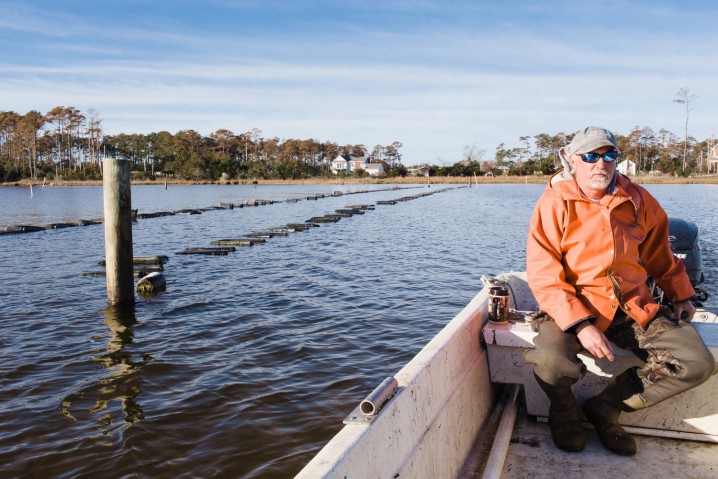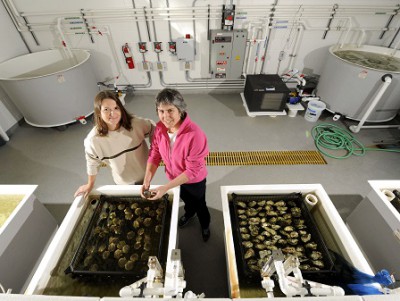PINE KNOLL SHORES – “Oysters have been getting a lot of press lately,” Greg “Rudi” Rudolph, Carteret County’s shore protection officer, said during the N.C. Beach, Inlet and Waterway Association’s recent two-day meeting of at the N.C. Aquarium. The trend will continue, if a number of shellfish advocates have their way.
Oyster evangelists are spreading the word about how new aquaculture techniques, marketing ideas and state and private investment in North Carolina’s shellfish resources could lead to an unusual pairing of economic development and environmental improvement.
Supporter Spotlight
Oysters are living filters and improving their numbers helps improve water quality. That they are also a culinary delicacy that provides the perfect accompaniment to the state’s booming craft beer, wine and tourism industries has both environmentalists and capitalists licking their chops.
Community leaders are getting on board with the idea. Beaufort’s town commission earlier this month approved a resolution supporting the state’s plans for oyster restoration as a way to enhance the environment and economy of the N.C. coast. Other towns, including Pine Knoll Shores, are also set to consider similar resolutions.

Sens. Harry Brown, R-Onslow, and Norm Sanderson, R-Pamlico, said at the meeting that the state’s move toward restoration and capitalizing on the results is gaining favor with lawmakers from across the state.
“This past budget we probably spent $2 million plus $2 million more in the budget for oyster restoration and I think we’ll continue to get as much money as possible for that. I think it’s got legs now and it’s something we’ll continue to do,” Brown said.
Sanderson agreed. “We’re being out-produced probably 10 to one by Virginia and we’ve got a whole lot more coastal habitat that’s more suitable and it’s a win-win situation,” he said. “The first hurdle we had to get over was convincing the commercial people we weren’t trying to take their industry away from them, but I think we’re over that hurdle and, after we get it how we want to do it, we can begin to lay this out and move forward.”
Creating Jobs, New Markets
Rudolph’s comment about the recent focus came as he introduced a panel discussion on restoring the state’s once-thriving oyster industry. The discussion included an oyster-farming entrepreneur, representatives from economic-development organizations, a N.C. Division of Marine Fisheries official and Todd Miller, director of the N.C. Coastal Federation, an environmental group that makes oyster restoration a top priority.
“This is an opportunity to not only do something great for the environment on the coast but also the economy,” Miller said. He referenced a recent study of several North Carolina coastal restoration projects that showed an $8 million investment in four different coastal restoration projects in the state created 116 jobs, $13.8 million in revenue to coastal community businesses and produced an added $4.1 million to coastal community household earnings.

The study by RTI International of Research Triangle Park for the Albemarle-Pamlico National Estuary Partnership showed that for every $1 million invested in coastal restoration 10 to 30 jobs are created, depending on the type of project. The research also found that the relatively low-cost approach to coastal restoration benefits industries that are key to North Carolina’s coastal economy, including commercial and recreational fishing and tourism.
The Albemarle-Pamlico National Estuary Partnership is an effort by the N.C. Department of Environmental Quality with funding from the U.S. Environmental Protection Agency. Its program area covers most of the Albemarle-Pamlico watershed, including the Neuse, Tar-Pamlico, Pasquotank, Chowan, lower Roanoke and parts of the White Oak River basins.
The report, “Economic Analysis of the Costs and Benefits of Restoration and Enhancement of Shellfish Habitat and Oyster Propagation in North Carolina,” shows that just over $20 million in government and private investment in years 2010-15 supported more than 500 acres of habitat, benefited commercial and recreational fishing activities and improved water quality. The investment yielded $82 million in benefits, according to the research.
Benefits included nearly 700 jobs created over the period, $32 million in revenue generated for N.C. businesses and $13 million added to household incomes.
Every dollar invested in habitat enhancement activities provided North Carolina with about $4.05 in benefits, according to the study.
State Research

The RTI report is not the only recent study of its kind, state officials are taking a close look, too.
Steve Murphey, chief of the Habitat and Enhancement Section of the N.C. Division of Marine Fisheries, said the legislature ordered his department to provide a half-dozen or so reports in time for the session that began last week. Three of the reports deal specifically with oysters, he said during the discussion.
The reports focus on changing existing law related to developing the proposed Sen. Jean Preston Oyster Sanctuary, a 10-year plan for a network of protected oyster beds in the Albemarle and Pamlico sounds; recommendations relevant to shellfish aquaculture, oyster restoration and oyster diseases; and opening a portion of Core Sound to leasing following a moratorium there on shellfish leases that dates back to about 1993.
“We also were given money to contract with UNC-Wilmington to develop oyster brood stock,” Murphey said, adding that the brood stock lines are species “that do very well in our waters.”
Murphey said demand exceeds supply and more hatcheries are needed. Also needed, he said is a long-term, statewide shellfish aquaculture plan to put North Carolina in a more competitive position with other states that have developed successful shellfish industries. Most successful states have a plan in place, “so I don’t really think we have to reinvent the wheel,” he said.
The appeal of shellfish aquaculture enticed Jay Styron, a Carteret County native now living in Wilmington. Styron started Carolina Mariculture Co. in 2007 to enter the premium oyster market, a business segment in which North Carolina oysters hadn’t competed. His method of off-bottom farming in cages at Cedar Island produces oysters for the half-shell market, which demands consistent shell shape and quality that aren’t otherwise possible here. Farmed oysters command a higher price and are branded, carrying the name of the place where they’re grown.
“You’re not just transporting a product from coastal communities out, you’re taking that name with them,” Styron said during the meeting.
Not only does Styron’s operation in Cedar Island cater to a separate clientele than less expensive bagged oyster and shucked oyster markets it’s also productive year-round, not just during the cool-weather “ending-with-R” months most in eastern North Carolina consider oyster season.
Styron’s methods offer advantages to watermen who can’t make a living harvesting wild oysters. Wild stock is down to about 5 percent of what it was in the early 1900s, Styron said. Innovations in oyster farming offer new hope for those wanting to stay in the business.
“Wild fisheries are never going to be able to support the economy and support the demand for oysters, so we had to find another way to grow oysters,” Styron said.
The Blue Economy

Jane Harrison, a coastal economist with North Carolina Sea Grant and another member of the panel, said a revitalized oyster industry in North Carolina could be a boon to the state’s “blue economy,” which refers to sustainable coastal industries such as seafood, tourism, maritime transportation, boatbuilding and recreation. The blue economy contributes about $1.8 billion in gross domestic product, or about 6 percent of the total GDP for coastal counties and provides 41,000 jobs, or about 13 percent of coastal employment, she said.
“Oyster restoration and aquaculture, they can certainly fit very neatly in this seafood piece, but there’s actually a lot more to it,” Harrison said. They also fit with tourism and recreation, which provide many more jobs than seafood, she said.
“Most of the jobs on the coast that are really dependent on our coastal resources, our ocean resources, are tourism and rec,” she said, adding that visitors often want to learn about the fishing heritage on the coast.
Restoration also enhances the “natural capital base” that supports many coastal activities, Harrison said, noting the involvement of many state, federal and nonprofit partners, as well as the seafood industry. Oyster restoration not only creates jobs, she said, “it also creates an infrastructure for the seafood industry, for aquaculture, for the tourism and recreation sectors.”
Neighboring states, particularly Virginia, have shown that investment in oyster restoration helps grow the economy, said Tom Looney, who serves with the N.C. Economic Development Partnership and was also part of the panel discussion. Market prices for oysters have gone up for these states as production has increased, he said.
“They created a vibrant export market,” Looney said.
Restoration improves habitat for other species and that leads to increased commercial fishing landings, Looney explained. A growing seafood industry begets more coastal restoration.
“We have to protect that habitat to make sure the industry succeeds. I believe the oyster is the ultimate clean tech,” Looney said.








